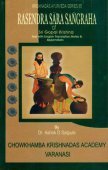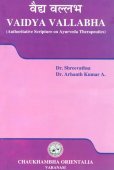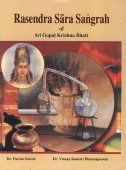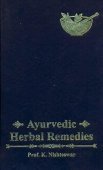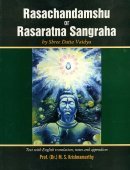Udararoga, Udara-roga: 7 definitions
Introduction:
Udararoga means something in Hinduism, Sanskrit. If you want to know the exact meaning, history, etymology or English translation of this term then check out the descriptions on this page. Add your comment or reference to a book if you want to contribute to this summary article.
In Hinduism
Ayurveda (science of life)
Kalpa (Formulas, Drug prescriptions and other Medicinal preparations)
Source: Shodhganga: Edition translation and critical study of yogasarasamgrahaUdararoga (उदररोग) refers to “diseases of abdomen” and is one of the various diseases mentioned in the 15th-century Yogasārasaṅgraha (Yogasara-saṅgraha) by Vāsudeva: an unpublished Keralite work representing an Ayurvedic compendium of medicinal recipes. The Yogasārasaṃgraha [mentioning udararoga] deals with entire recipes in the route of administration, and thus deals with the knowledge of pharmacy (bhaiṣajya-kalpanā) which is a branch of pharmacology (dravyaguṇa).
Rasashastra (Alchemy and Herbo-Mineral preparations)
Source: Wisdom Library: Rasa-śāstraUdararoga (उदररोग) refers to “diseases affecting the belly” according to the fourth volume of the Rasajalanidhi (chapter 6). Accordingly, “slowness of the digesting heat is the cause of all sorts of diseases and especially of those affecting the belly [i.e., udararoga]. The latter arise out of indigestion, eating of dirty food, and accumulation of stool in the intestines. What happens just before the appearance of these diseases is this:—abnormal excess of the three doshas, accumulated for a long time, block the passages carrying sweats and other fluids, and thereby pollute the prana-vayu, the apana-vayu, and the digesting heat. The following are the common symptoms characterising all sorts of diseases affecting the belly [i.e., udararoga]:—flatulence, difficulty experienced in movement, weakness, weakness of the digesting heat, swelling of some of the limbs, lethargy felt in the movement of the limbs, difficulty in passing wind and stool, heating sensation, and drowsiness”.
There are eight (plus one) different kinds of Udararogas defined:
- Vātodara (formation of gas in the stomach),
- Pittodara (stomach affected by an abnormal excess of pitta),
- Kaphodara stomach affected by an abnormal excess of kapha),
- Tridoṣodara or Dūṣyodora (stomach affected by an abnormal excess of the three dosas),
- Plīhodara and Jakṛdudara (enlargement of spleen and liver),
- Baddhodara (malignant constipation),
- Kṣatodara (ulcer in the belly),
- Jalodara (dropsy),
- Mahodara (combination of more than one udararoga)
Unclassified Ayurveda definitions
Source: Research Gate: Internal applications of Vatsanabha (Aconitum ferox wall)Udararoga (उदररोग) refers to “disease of abdomen”. Medicinal formulations in the management of this condition include 19 references of Vatsanābha usages. Guṭikā is maximum (16) dosage form in the management of Udararoga. Vatsanābha (Aconitum ferox), although categorized as sthāvara-viṣa (vegetable poisons), has been extensively used in ayurvedic pharmacopoeia.
Source: Ancient Science of Life: Vaidyavallabha: An Authoritative Work on Ayurveda TherapeuticsUdararoga (उदररोग) refers to “ascites”, and is dealt with in the 17th-century Vaidyavallabha (chapter 6) written by Hastiruci.—The Vaidyavallabha is a work which deals with the treatment and useful for all 8 branches of Ayurveda. The text Vaidyavallabha has been designed based on the need of the period of the author, availability of drugs during that time, disease (viz., udararoga) manifesting in that era, socio-economical-cultural-familial-spiritual-aspects of that period Vaidyavallabha.

Āyurveda (आयुर्वेद, ayurveda) is a branch of Indian science dealing with medicine, herbalism, taxology, anatomy, surgery, alchemy and related topics. Traditional practice of Āyurveda in ancient India dates back to at least the first millenium BC. Literature is commonly written in Sanskrit using various poetic metres.
Languages of India and abroad
Sanskrit dictionary
Source: Cologne Digital Sanskrit Dictionaries: Monier-Williams Sanskrit-English DictionaryUdararoga (उदररोग):—[=udara-roga] [from udara] m. disease of the stomach or bowels, [Varāha-mihira’s Bṛhat-saṃhitā]
[Sanskrit to German]
Sanskrit, also spelled संस्कृतम् (saṃskṛtam), is an ancient language of India commonly seen as the grandmother of the Indo-European language family (even English!). Closely allied with Prakrit and Pali, Sanskrit is more exhaustive in both grammar and terms and has the most extensive collection of literature in the world, greatly surpassing its sister-languages Greek and Latin.
See also (Relevant definitions)
Partial matches: Roga, Udara, Roka.
Starts with: Udararogacikitsa.
Full-text (+18): Mahodara, Tamra, Rajata, Dushyodora, Kshatodara, Baddhodara, Tridoshodara, Anaha, Pittodara, Vatodara, Kaphodara, Pippalyadya, Mahabahni, Shitasevananta, Jalodarahara, Udarari, Mahanala, Naraca, Trailokyasundara, Icchabhedi.
Relevant text
Search found 8 books and stories containing Udararoga, Udara-roga; (plurals include: Udararogas, rogas). You can also click to the full overview containing English textual excerpts. Below are direct links for the most relevant articles:
Rasa Jala Nidhi, vol 4: Iatrochemistry (by Bhudeb Mookerjee)
Part 25 - Treatment of Udara-roga (22): Application of parpati < [Chapter VI - Diseases affecting the belly (udara-roga)]
Part 1 - Characteristics of Udara-roga (diseases affecting the belly) < [Chapter VI - Diseases affecting the belly (udara-roga)]
Part 15 - Treatment of Udara-roga (12): Biraja rasa < [Chapter VI - Diseases affecting the belly (udara-roga)]
Atharvaveda and Charaka Samhita (by Laxmi Maji)
3b. Udararoga (Udara disease) in the Caraka-saṃhitā < [Chapter 5 - Diseases and Remedies in Atharvaveda and Caraka-Saṃhitā]
3a. Udararoga (gastroenterological diseases) in the Atharvaveda < [Chapter 5 - Diseases and Remedies in Atharvaveda and Caraka-Saṃhitā]
Rasendrasāra Saṅgraha (Āyurveda book) < [Chapter 1 - Introduction]
Charaka Samhita (English translation) (by Shree Gulabkunverba Ayurvedic Society)
Chapter 19 - The Eight Abdominal affections (udara-roga) < [Sutrasthana (Sutra Sthana) — General Principles]
Rasa Jala Nidhi, vol 3: Metals, Gems and other substances (by Bhudeb Mookerjee)
Part 2 - Semi-poison (2): Arka < [Chapter XXXI - Upavisha (semi-poisons)]
Part 9 - Semi-poison (9): Bhallataka < [Chapter XXXI - Upavisha (semi-poisons)]
Part 3 - Incineration of copper < [Chapter III - Metals (3): Tamra (copper)]
Rasa Jala Nidhi, vol 2: Minerals (uparasa) (by Bhudeb Mookerjee)
Part 3 - Incineration of shilajatu < [Chapter IV - Uparasa (4): Shilajatu or Shilajit (bitumen)]
Part 1 - Characteristics of Pyrite (makshika) < [Chapter II - Uparasa (2): Makshika (pyrites)]
Part 1 - Characteristics of Shilajatu or Shilajit (bitumen) < [Chapter IV - Uparasa (4): Shilajatu or Shilajit (bitumen)]
Rasa Jala Nidhi, vol 5: Treatment of various afflictions (by Bhudeb Mookerjee)
Related products
